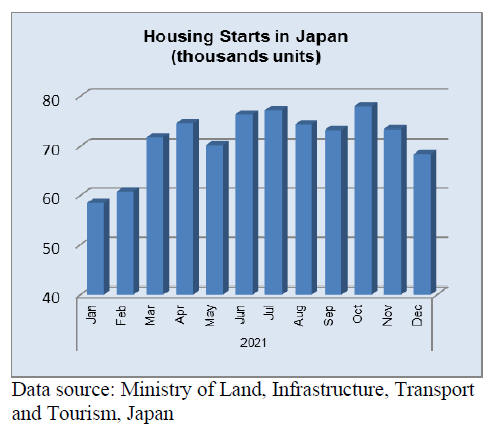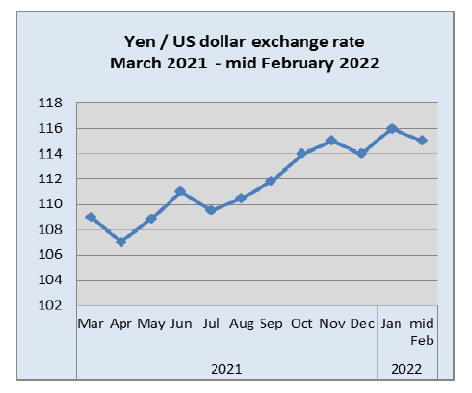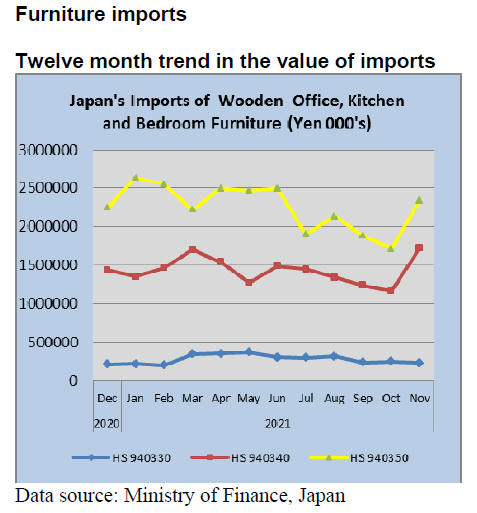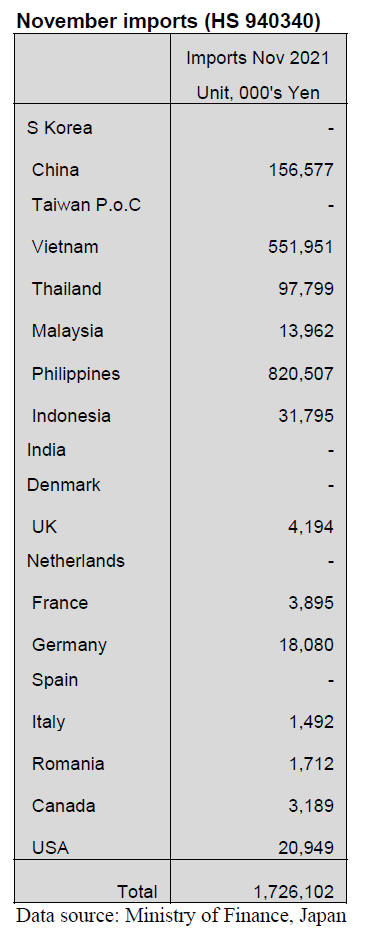Japan
Wood Products Prices
Dollar Exchange Rates of 10th
Feb
2022
Japan Yen 115.45
Reports From Japan
Forecast decline in growth in
Q1
Prominent economists have suggested the Japanese
economic growth is likely to decline in the first
quarter of 2022 because the latest surge in Omicron
cases has dented prospects. The number of reported
covid cases in Japan topped 100,000 in early
February as the country struggles to contain a sixth
wave of infections driven by the Omicron variant.
The total number of coronavirus cases reported in
Japan is around 4 million.
Consumer confidence fell in January suggesting
consumer had cut back on spending. In addition,
prospects for manufacturing output weakened with
one of the top car makers saying it had cut
production. The general view is that until the booster
shot programme is speeded up confidence wil be
undermined.
GDP had a roller coaster ride in 2021 falling an
annualised 2.9% in January¨CMarch 2021 after which
it recovered growing 2% in April¨CJune quarter but
fell back again in the July¨CSeptember quarter only to
move back into positive numbers in the fourth quarter
of the year as restrictions were lifted and the chip and
parts supply issue was partially overcome.
In fiscal 2022 GDP is forecast to increase around 3%
but the full impact of the Omicron variant has not
been factored into this estimate.
See:
https://www.japantimes.co.jp/news/2022/02/02/business/economy-shrink-covid-omicron/
and
See:
https://www.nippon.com/en/in-depth/d00778
More foreigners allowed to enter
The government has changed its view on the entry of
foreigners after lobbying by Japanese businesses.
Masakazu Tokura, chairman of the Japan Business
Federation (Keidanren) said it is unrealistic for the
government to ban the entry of foreign nationals with
the new omicron coronavirus variant having become
prevalent within the country¡±.
On the issue of the government¡¯s suggestion that
wages should be raised by 3% Tokura commented
that having a standard level for wage increases was
unrealistic as conditions vary from company to
company and sector by sector.
Last year major Japanese companies offered the
lowest wage increases (below 2%) in eight years as
the pandemic hit corporate profits.
https://www.japantimes.co.jp/news/2022/01/24/business/keidanren-travel-ban-japan-unrealistic/

Remote working cause of relocation from Tokyo
More people moved out of Tokyo than moved in
during 2021, the first time this has been recorded.
The Ministry of Internal Affairs and Communications
has reported the number of people moving into
Tokyo outnumbered those leaving by 5,433 last year.
This change if sustained will impact demand for
housing. The capital's total population also declined
for the eighth consecutive month since June 2021,
down 9,872 from the previous month.
A Cabinet Office survey found people who decided
quoted "the implementation of teleworking" was
35.4% before the pandemic, the current figure is at
47.9%.
Yutaka Murayama, a Director General at the Cabinet
Office said, "People who already had an interest in
moving out of the city were prompted to move by the
fact that the coronavirus pandemic made teleworking
in regional areas possible."

Labour shortages and supply side disruptions
could drag down production
Between January 2021 (a 9-month high) and January
2022 (a 4-year low) the yen depreciated about 13%
against the US dollar but has stablised recently.
Looking ahead to 2022 it is likely that labour
shortages, made worse by self-isolation rules and the
continuing supply side shortages are likely to further
pull down production output thus undermining the
ability of manufacturers/exporters to fully benefit
from a competitively priced yen.


Office furniture imports (HS 940330)
The value of Japan¡¯s wooden office furniture imports
(HS940330) remained on a steady track throughout
2021 and are set to end the year higher than in 2020
and even higher than in 2019.
In November 2021 the year on year value of imports
of wooden office furniture were 15% up on 2020 but
compared to the value of October¡¯s imports there was
a 7% decline.
The top shipper of wooden office furniture to Japan
in November 2021 was China taking an 82% share
of the total value of wooden office furniture imports.
This was a significant rise on the 66% share in
October this year.
The US was the second ranked supplier in November
providing a further 4% of imports but this was less
than half than in October. Imports from Taiwan P.o.C
dropped by half in November and there were small
imports from Vietnam, Poland and Thailand.

Kitchen furniture imports (HS 940340)
After four months of steady decline the value of
Japan¡¯s imports of wooden kitchen furniture
(HS940340) more than doubled in November and
year on year there was a 20% increase in imports in
November last year. Monthly imports of wooden
kitchen furniture were volatile in 2021 moving from
peaks and dips, unlike the more steady flow of
imports in 2019. The value of imports in the first 11
months of 2021 were higher than in 2020 and had
reached almost the same level as in 2019.
Year on year, the value of November 2021 imports
was 20% up on November 2020 with the Philippines
being the major shipper accounting for around 48%
of November 2021 import values. Shippers in
Vietnam came a close second in November
accounting for 32% of imports with China
acoounting for a further 9%.

Bedroom furniture imports (HS 940350)
Since mid-2021 there has been a downward trend in
the value of Japan¡¯s imports of wooden bedroom
furniture (HS940350) but this was reversed in
November when the value of Japan¡¯s imports shot
higher. Compared to October there was a more than
35% rise in the value of November imports.

In the first 11 months of 2021 the value of imports
of
wooden bedroom furniture was around 7% higher
than in 2020 but had recovered to the same level as in
2019.
The top suppliers in terms of value in November, as
was the case throughout 2021,were were China 62%
(72% in October) and Vietnam 29% (20% in
October).
Shipments from both China and Vietnam in October
were down being impacted mainly by logistic
problems. With these two main shippers accounting
for over 90% of the value of November imports,
other shippers had to be content with small
shipments. Only shippers in Thailand managed to
maintain the same level of exports to Japan in
November.
Trade news from the Japan Lumber Reports (JLR)
The Japan Lumber Reports (JLR), a subscription
trade journal published every two weeks in English,
is generously allowing the ITTO Tropical Timber
Market Report to reproduce news on the Japanese
market precisely as it appears in the JLR.
For the JLR report please see:
https://jfpj.jp/japan_lumber_reports/
Projection of import wood products
The Japan Lumber Importers Association disclosed
projection of imported wood products for the first
half of this year. It becomes obvious that log import
will decrease after Russia bans log export so North
America becomes main source of log import. On
lumber import, North America and Europe hold 74%
of lumber supply share.
Estimated volume will exceed last year¡¯s volume
except for South Sea lumber. Confusion of supply
chain continues but volume of imported lumber is
increasing at major ports.
Supply of logs and lumber from North America
seems uncertain because of active housing starts in
the U.S.A, and supply is confused by weather factors
like flood and handling at loading ports by lack of
workers and increased cargoes.
European supply should improve but high cost
remains. Russian lumber is expected to recover as it
is all dries products now so increase of supply of stud
and lamina is expected.
Price hike in domestic softwood plywood
Some plywood companies in Eastern and Western
Japan decided to raise the price of 3x6 of 12mm as of
February. The price will be ¥1,600 per sheet
delivered. This is ¥ 100 up from January. As per cbm,
it will be ¥80,000 and this is ¥5,000 up.
Domestic logs are now very high-priced due to tight
supply and the imported logs are high-priced as well.
So the domestic plywood companies had no choice
but to raise the prices. 3x6 of 24mm is ¥3,200, ¥200
up from last month and 3x6 of 28mm is ¥3,750, ¥250
up from last month.
The reason of raising prices is that the prices of logs
increased at the year-end and New Year holiday.
There is a competition for cedar logs for plywood in
Easter Japan by laminated lumber companies. Since
there was a heavy snow covered Eastern Japan, there
were not enough logs at the markets and that made an
increasing price of logs.
The cedar logs for plywood in some areas of Eastern
Japan costs ¥2,500 as per cbm and it is about ¥ 1,000
more than last month. Other areas of Eastern Japan, it
costs ¥17,000 as per cbm because of intensification
of competition by laminated lumber companies.
Plywood companies in Western Japan also try to
collect cedar logs from various markets including
Eastern Japan, so the prices went up as well as
Eastern Japan¡¯s situation. Not only cedar logs, but
also larch logs cost higher. It is ¥20,000 - ¥22,000 as
per cbm, ¥2,000 increased. It is very difficult to buy
cypress logs in Western Japan as well.
The imported Russian larch veneer has not arrived to
Japan on time, which is one of main materials to
produce plywood because of confused of vessels and
bad weather in Russia. It is influencing the
production of laminated 12mm lumber in Japan.
There are not enough supply of logs from North
America and export prices are climbing. So it is very
hard to cover a shortage of logs in Japan. The
demand of plywood in Japan is still lively so the
difficult situation keeps going for some time.
Imported substitution materials like tropical structural
plywood and wooden board also tight in supply so
the market has no choice but to wait for supply from
domestic plywood mills. Like precutting plants,
plywood supply is key to the operations and there is
no complaint on prices.
A delay of vessels
There is still delay of importing European lumber due
to difficulty of loading and unloading at ports in the
world. There is no confusion of production and
transfer from plants to the ports in Europe, but there
is a delay at ports which further stagnate container
handlings.
There are not enough containers as well. This
situation will continue for a while because Chinese
New Year and Beijing Winter Olympics were held in
February which stagnate transshipment of containers.
For example, it takes a week to transport from
northern Europe to Central Europe normally, but it
takes three to four weeks because of shortage of
feeder vessels in Europe. Around Singapore through
China, electric products and food are given priority
on loading and unloading at ports.
Also, a delay occurs at Busan port in Korea and that
makes a schedule of vessels delay to Japan. The other
reason of delay is that the sea around Japan is rough
in winter.
As a result of these confusions, third quarter
contracted cargoes continue arriving through
February and the fourth quarter contracted cargoes
will not arrive Japan until April. Arrival of the first
quarter volume will be in May. In short, the prices of
earlier quarters will influence the market for
prolonged time.
Review of 2021
On 7 January 2021 the state of emergency was
declared on COVID 19 pandemic, which was the
second emergency declaration since April 2020.
Everybody anticipated stormy year with this
declaration since imported wood prices soared with
expansion of the demand in the North America and
China in 2020 and available volume decreased.
However, nobody anticipated that wood products
prices skyrocketed with very tight supply until wood
shock hit the market.
New demand by nesting to avoid pandemic increased
worldwide then unexpected confusion of marine
transport occurred, which resulted in very tight
supply of imported wood products. Grave situation
became apparent in March when container ship ran
aground at the Suez Canal, which blocked canal
traffic.
This is the route of European wood products for
Japan and lamina supply stopped. Major laminated
lumber manufacturers had to reduce the production
and this impacted precutting operations. This created
chaos in the market and precutting plants bought
materials haphazardly and the demand centered on
domestic wood products since imported.
products are not available. Domestic wood products
prices rocketed up. In the third quarter negotiations
with overseas suppliers, volume is priority than
prices. The prices are record high. Canadian SPF
lumber prices shot up to US$1,800 per MBM C&F,
3.6 times higher than the bottom then European
laminated lumber prices soared to Euro 850-1,150
per cbm C&F, two to three time higher.
Supply shortage and higher prices are common on all
the wood products and the market prices increased to
coordinate climbing future contract prices of overseas
products.
There was no resistance to higher prices so the
importers, dealers and precutting plants could pass
higher prices without any problem so they enjoyed
unprecedented profit. In particular, domestic lumber
mills made record breaking profit. However, shortage
of softwood plywood was unexpected incident.
Raw material is 90% domestic wood so supply
shortage of imported wood was thought nothing to do
with domestic plywood supply but the demand was
so large that full production cannot satisfy the
demand. One of the reasons is difficulty of log
procurement because of competition with lumber and
laminated lumber manufacturers.
In short, everything was tight and the prices are high.
Fortunately, house builders accepted higher prices to
secure the necessary materials when demand of house
recovered and house buyers are aware of inflation of
building materials.
Covid 19 pandemic continues worldwide in 2022.
Confusion of marine transport and shortage of
containers seems to continue in 2022. Overshot
prices of wood products are likely to drop but not to
the level before the wood shock days.
Covid 19 pandemic changed housing market.
Because of stay-home quarantine and remote work,
demand of suburban house increased and people are
restricted to travel so they send more money for
house renovation. Not only wood products but prices
of other basic materials such as steel and crude oil
escalated in 2021. Crude oil prices renewed seven
years high in October. Higher oil prices pushed prices
of oil based products such as chemical products like
adhesive.
|